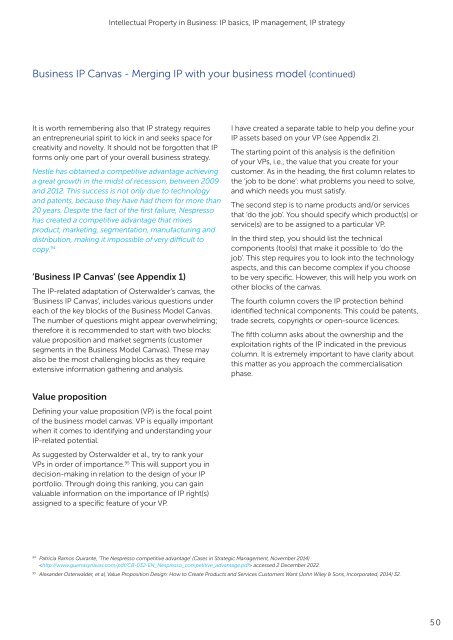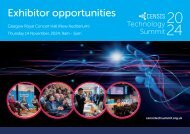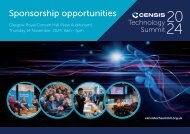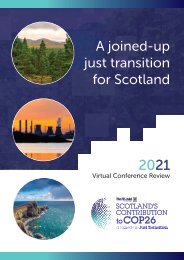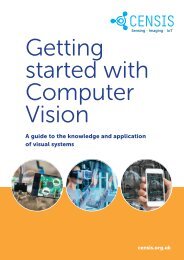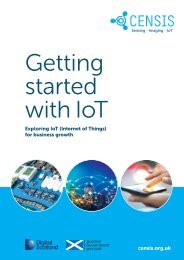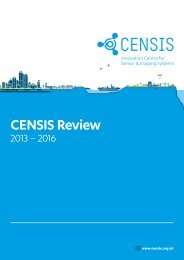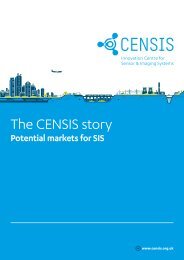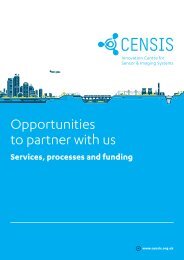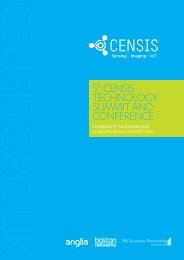CENSIS white paper: Intellectual Property in Business
2023: This CENSIS white paper sets out to make the topic of IP more approachable, less intimidating and more manageable, offering experience-based advice and methods are are designed to help businesses structure their IP- related issues and makes the best of their IP. Covering: The role of IP, IP management during growth, IP strategy for expanding companies and corporates, Business IP Canvas - merging IP with your business model.
2023: This CENSIS white paper sets out to make the topic of IP more approachable, less intimidating and more manageable, offering experience-based advice and methods are are designed to help businesses structure their IP- related issues and makes the best of their IP.
Covering:
The role of IP, IP management during growth, IP strategy for expanding companies and corporates, Business IP Canvas - merging IP with your business model.
You also want an ePaper? Increase the reach of your titles
YUMPU automatically turns print PDFs into web optimized ePapers that Google loves.
<strong>Intellectual</strong> <strong>Property</strong> <strong>in</strong> Bus<strong>in</strong>ess: IP basics, IP management, IP strategy<br />
Bus<strong>in</strong>ess IP Canvas - Merg<strong>in</strong>g IP with your bus<strong>in</strong>ess model (cont<strong>in</strong>ued)<br />
It is worth remember<strong>in</strong>g also that IP strategy requires<br />
an entrepreneurial spirit to kick <strong>in</strong> and seeks space for<br />
creativity and novelty. It should not be forgotten that IP<br />
forms only one part of your overall bus<strong>in</strong>ess strategy.<br />
Nestle has obta<strong>in</strong>ed a competitive advantage achiev<strong>in</strong>g<br />
a great growth <strong>in</strong> the midst of recession, between 2009<br />
and 2012. This success is not only due to technology<br />
and patents, because they have had them for more than<br />
20 years. Despite the fact of the first failure, Nespresso<br />
has created a competitive advantage that mixes<br />
product, market<strong>in</strong>g, segmentation, manufactur<strong>in</strong>g and<br />
distribution, mak<strong>in</strong>g it impossible of very difficult to<br />
copy. 94<br />
‘Bus<strong>in</strong>ess IP Canvas’ (see Appendix 1)<br />
The IP-related adaptation of Osterwalder’s canvas, the<br />
‘Bus<strong>in</strong>ess IP Canvas’, <strong>in</strong>cludes various questions under<br />
each of the key blocks of the Bus<strong>in</strong>ess Model Canvas.<br />
The number of questions might appear overwhelm<strong>in</strong>g;<br />
therefore it is recommended to start with two blocks:<br />
value proposition and market segments (customer<br />
segments <strong>in</strong> the Bus<strong>in</strong>ess Model Canvas). These may<br />
also be the most challeng<strong>in</strong>g blocks as they require<br />
extensive <strong>in</strong>formation gather<strong>in</strong>g and analysis.<br />
I have created a separate table to help you def<strong>in</strong>e your<br />
IP assets based on your VP (see Appendix 2).<br />
The start<strong>in</strong>g po<strong>in</strong>t of this analysis is the def<strong>in</strong>ition<br />
of your VPs, i.e., the value that you create for your<br />
customer. As <strong>in</strong> the head<strong>in</strong>g, the first column relates to<br />
the ‘job to be done’: what problems you need to solve,<br />
and which needs you must satisfy.<br />
The second step is to name products and/or services<br />
that ‘do the job’. You should specify which product(s) or<br />
service(s) are to be assigned to a particular VP.<br />
In the third step, you should list the technical<br />
components (tools) that make it possible to ‘do the<br />
job’. This step requires you to look <strong>in</strong>to the technology<br />
aspects, and this can become complex if you choose<br />
to be very specific. However, this will help you work on<br />
other blocks of the canvas.<br />
The fourth column covers the IP protection beh<strong>in</strong>d<br />
identified technical components. This could be patents,<br />
trade secrets, copyrights or open-source licences.<br />
The fifth column asks about the ownership and the<br />
exploitation rights of the IP <strong>in</strong>dicated <strong>in</strong> the previous<br />
column. It is extremely important to have clarity about<br />
this matter as you approach the commercialisation<br />
phase.<br />
Value proposition<br />
Def<strong>in</strong><strong>in</strong>g your value proposition (VP) is the focal po<strong>in</strong>t<br />
of the bus<strong>in</strong>ess model canvas. VP is equally important<br />
when it comes to identify<strong>in</strong>g and understand<strong>in</strong>g your<br />
IP-related potential.<br />
As suggested by Osterwalder et al., try to rank your<br />
VPs <strong>in</strong> order of importance. 95 This will support you <strong>in</strong><br />
decision-mak<strong>in</strong>g <strong>in</strong> relation to the design of your IP<br />
portfolio. Through do<strong>in</strong>g this rank<strong>in</strong>g, you can ga<strong>in</strong><br />
valuable <strong>in</strong>formation on the importance of IP right(s)<br />
assigned to a specific feature of your VP.<br />
94<br />
Patricia Ramos Quirante, ‘The Nespresso competitive advantage’ (Cases <strong>in</strong> Strategic Management, November 2014)<br />
accessed 2 December 2022.<br />
95<br />
Alexander Osterwalder, et al, Value Proposition Design: How to Create Products and Services Customers Want (John Wiley & Sons, Incorporated, 2014) 32.<br />
50


